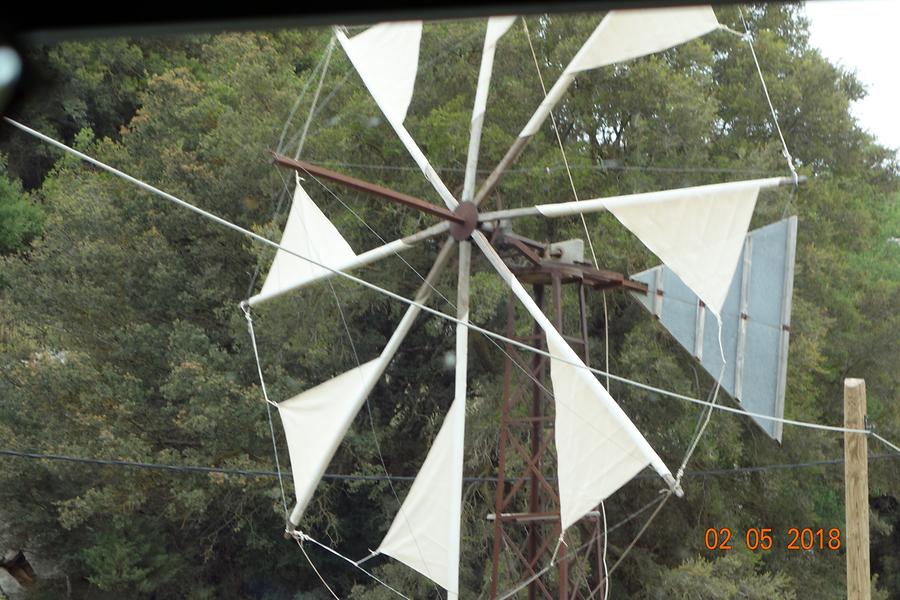Crete in pictures from a seven-day bus- tour#
Crete
Greece, Crete
has an area of 8261 square kilometers, making it the largest Greek island. It has a population of 623,000. North of the island is the sea of Crete, south is the Lybian sea. Crete is quite mountainous. A chain of mountains stretches all the way from East to West reaching an elevation of up to 2.500 m. Almost all potos were taken by Werner Gobiet, except in the few cases were other sources are mentioned in the captions.
Monastery Arkadi#
The monastery is first mentioned in writing in the 14 th century. Its spiritual and culturual importance continued until 1866, when it was destroyed by the Osman army. The monastry was desparately defended for two days. But when it became clear that the resistinace would not be enough everyone in the monastery (fighters, women and children) went into the gun-powder storage room and blew themselves up, together with a good part of the monastery.
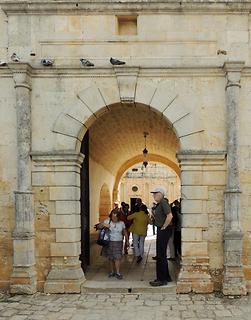
Entrance door
Photo: © Werner Gobiet, 13.4.2018

Church of monastery
Photo: © Werner Gobiet, 13.4.2018
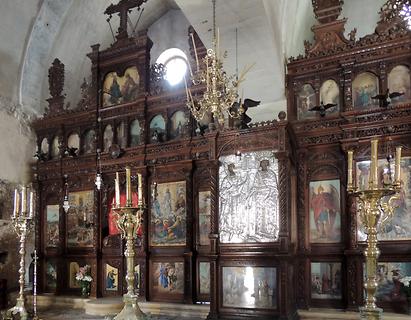
Altar
Photo: © Werner Gobiet, 13.4.2018
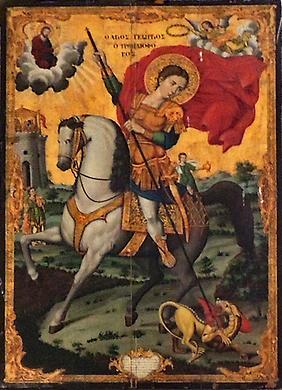
Saint George
Photo: © Werner Gobiet, 13.4.2018
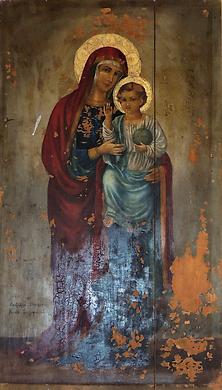
Mary with child Jesus
Photo: © Werner Gobiet, 13.4.2018
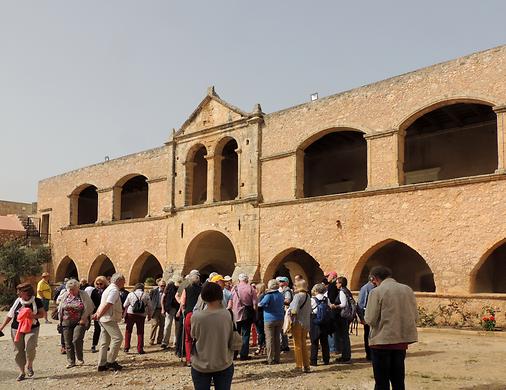
Garden of monastery 1
Photo: © Werner Gobiet, 13.4.2018
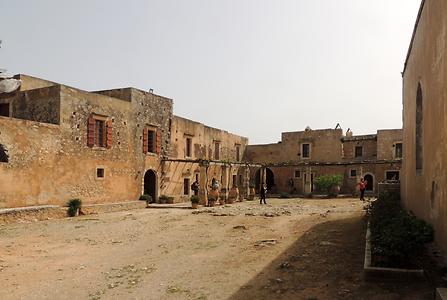
Garden of monastery 2
Photo: © Werner Gobiet, 13.4.2018
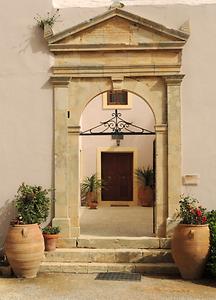
The seat of the abbot was destroyed in the 1866 uprising but rebuilt in 1905
Photo: © Werner Gobiet, 13.4.2018
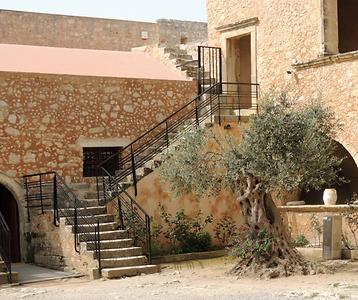
Stairs
Photo: © Werner Gobiet, 13.4.2018

Room for provisions: Food and living area for worker, pilgrims and the very poor
Photo: © Werner Gobiet, 13.4.2018

Wallpainting in the former dining roorm for monks, showing Mary and child Jesus
Photo: © Werner Gobiet, 13.4.2018
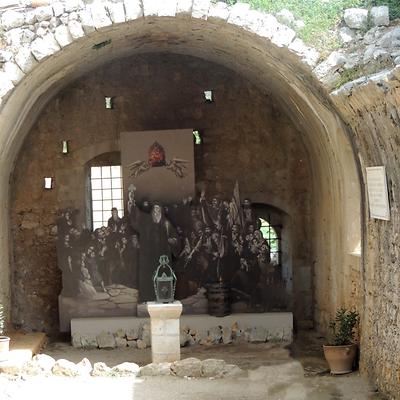
Memorial: Old wine cellar, later room for gun powder. Was destroyed by Omans by fire 1866.
Photo: © Werner Gobiet, 13.4.2018

The very old cyprus, also burnt in 1866 in a fire used by the Turks in the fight.
Photo: © Werner Gobiet, 13.4.2018
Archaeological Museum Elefthera#
The new museum was built next to the old city of Elefthera
Elefthera, Crete
. Exhibits range from the early ice to Byzantine times 3000 BCto 1300 A.D.,mainly form the old city of Eleftherna.

Building
Photo: © Werner Gobiet, 13.4.2018

Picture at entrance
Photo: © Werner Gobiet, 13.4.2018
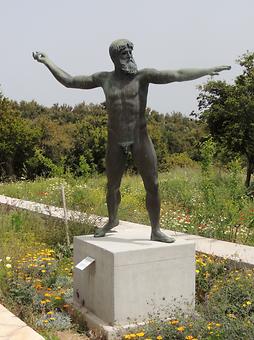
Sculpture
Photo: © Werner Gobiet, 13.4.2018

Meadow with flowers nearby
Photo: © Werner Gobiet, 13.4.2018
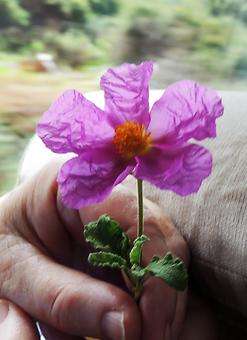
Flower
Photo: © Werner Gobiet, 13.4.2018
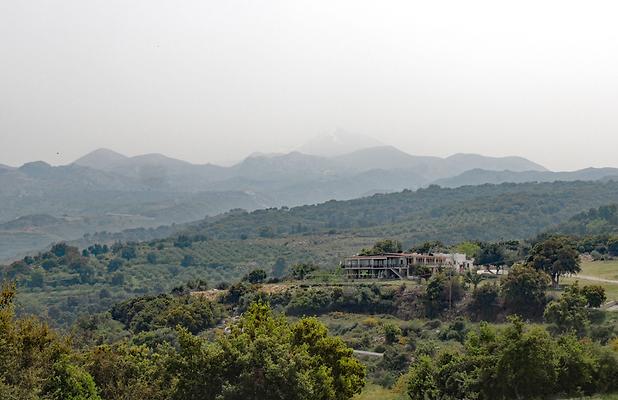
Landscape
Photo: © Werner Gobiet, 13.4.2018
Rethymnon#
Rethymnon
Rethymnon, greece
ist one of the most beautiful cities of Crete with currently some 22.000 inhabitants. Like many places west of Heraklion the old city has quite a bit of oriental flair and is still largely intact. The nice venitian harbour is an obvious place to start some strolling around, with many coffe houses and restaurants inviting visitors.
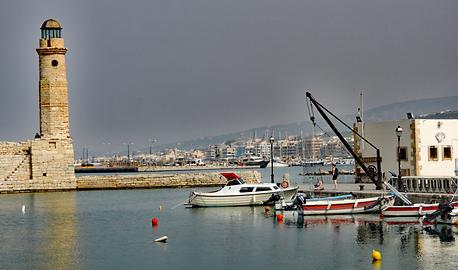
Venetian harbour
Photo: © Werner Gobiet, 13.4.2018
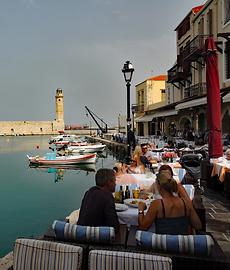
Fish-restaurant in Venetian harbour
Photo: © Werner Gobiet, 13.4.2018
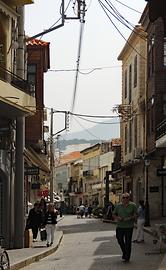
Old city 1
Photo: © Werner Gobiet, 13.4.2018

Old city 2
Photo: © Werner Gobiet, 13.4.2018
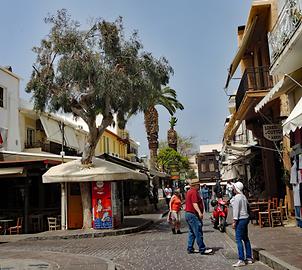
Old city 3
Photo: © Werner Gobiet, 13.4.2018
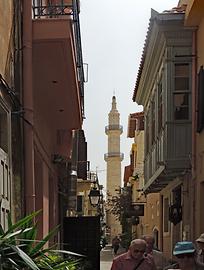
Old city 4
Photo: © Werner Gobiet, 13.4.2018
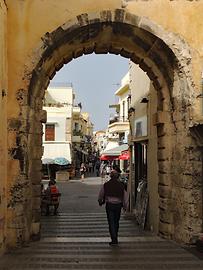
Door of Old city
Photo: © Werner Gobiet, 13.4.2018
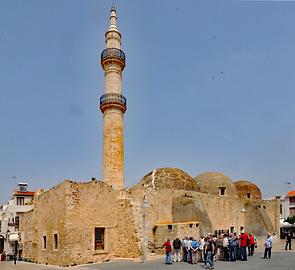
Mosque of Pasha Nerazze, today a school of music
Photo: © Werner Gobiet, 13.4.2018

Entrance to mosque
Photo: © Werner Gobiet, 13.4.2018

Rimondi-Well to provide water, 1629
Photo: © Werner Gobiet, 13.4.2018

Part of well.
Photo: © Werner Gobiet, 13.4.2018
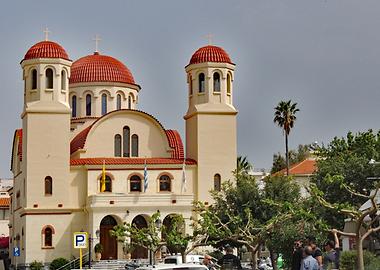
4-martyr church
Photo: © Werner Gobiet, 13.4.2018
Monastery Agia Triada#
The monastery is situated on the peninsula Akotiri
Akotiri, Crete
. It is the largest monastery on Crete. It was founded by the brothers Tzangarola in the 16 th century. The monastery is quite active also economically, producing bio-olive oil and bio-wine of highest quality. Those and other products can be purchased in the monastery's shop.
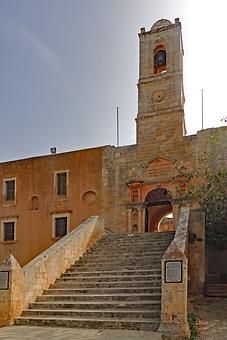
Approaching the monastery
Photo: © Werner Gobiet, 14.4.2018
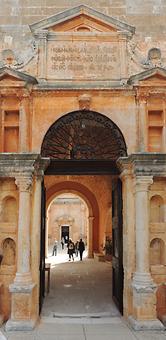
Entrance door
Photo: © Werner Gobiet, 14.4.2018
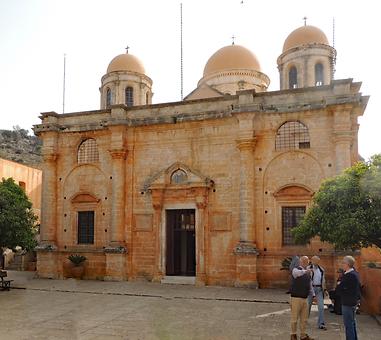
Monastery church
Photo: © Werner Gobiet, 14.4.2018

Monastery church, view form the back
Photo: © Werner Gobiet, 14.4.2018
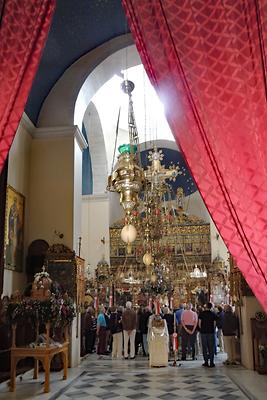
Interior of church
Photo: © Werner Gobiet, 14.4.2018
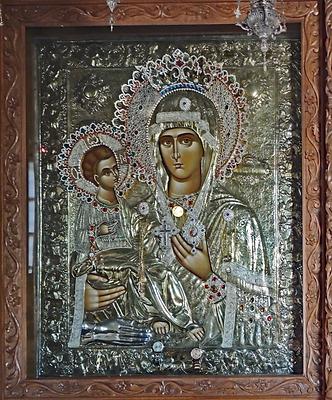
Icon: Mary with child Jesus
Photo: © Werner Gobiet, 14.4.2018
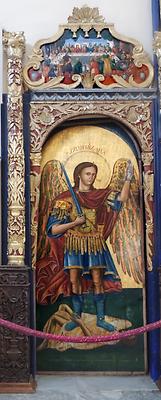
Monastery Triada
Photo: © Werner Gobiet, 14.4.2018
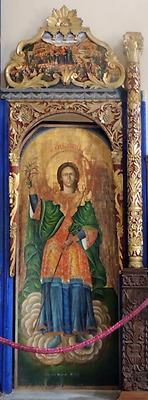
Monastery Triada
Photo: © Werner Gobiet, 14.4.2018

Monastery building
Photo: © Werner Gobiet, 14.4.2018
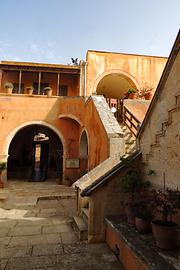
Stairs
Photo: © Werner Gobiet, 14.4.2018
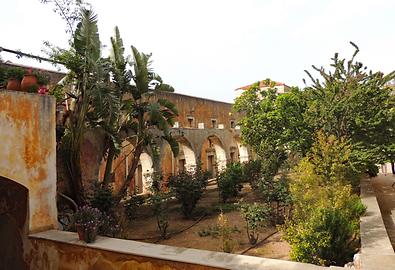
Monastery garden 1
Photo: © Werner Gobiet, 14.4.2018
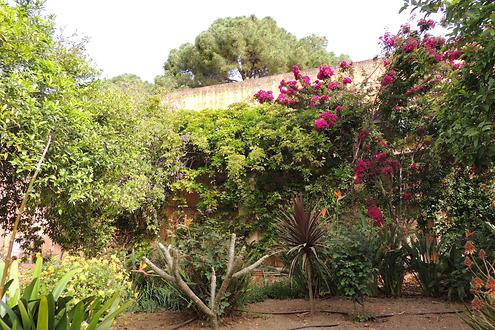
Monastery garden 2
Photo: © Werner Gobiet, 14.4.2018

Monastery garden 3
Photo: © Werner Gobiet, 14.4.2018
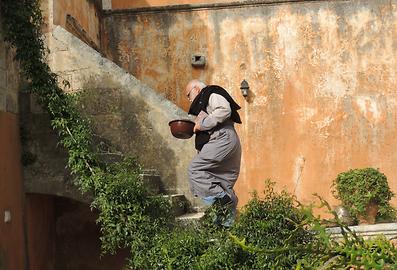
Monk in monastery garden
Photo: © Werner Gobiet, 14.4.2018
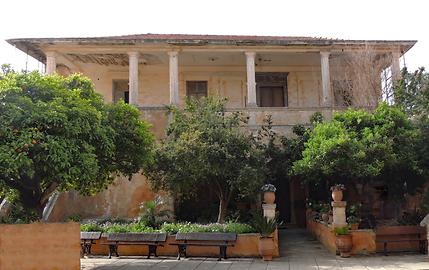
Building in monastery garden
Photo: © Werner Gobiet, 14.4.2018
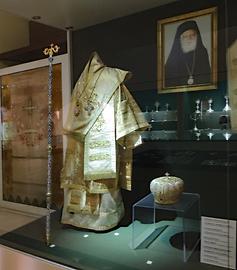
Gown of priest
Photo: © Werner Gobiet, 14.4.2018
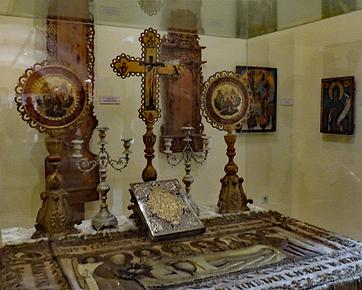
Altar pieces
Photo: © Werner Gobiet, 14.4.2018
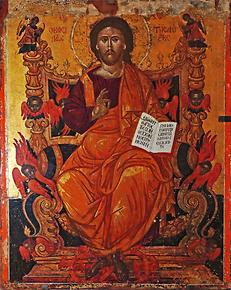
Panel with Christ
Photo: © Werner Gobiet, 14.4.2018
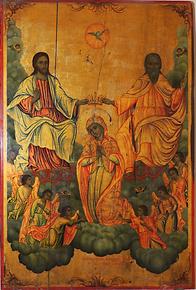
Panel crowning of Mary
Photo: © Werner Gobiet, 14.4.2018

Panel of Mary with Jesus
Photo: © Werner Gobiet, 14.4.2018
Burial monument of Eleftherios Venizelos#
Venizelos came from a simple family in Crete. He was a politician advocating that Crete should join Greece. He became prime minister of Greece in 1910. Crete did indeed join Greece just a few years later in 1913.
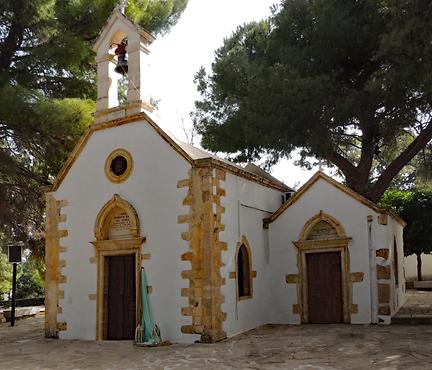
Burial chambers of Eleftherios Venizelos (1864 - 1936) and his son Sofoklis
Photo: © Werner Gobiet, 14.4.2018
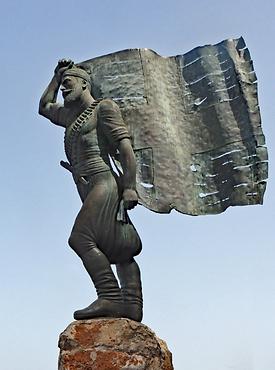
Spiros Kayales or Kayaledakis (1872 - 1929)
Photo: © Werner Gobiet, 14.4.2018
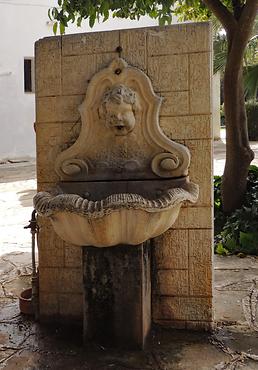
Fountain
Photo: © Werner Gobiet, 14.4.2018

Flowers in the Park
Photo: © Werner Gobiet, 14.4.2018
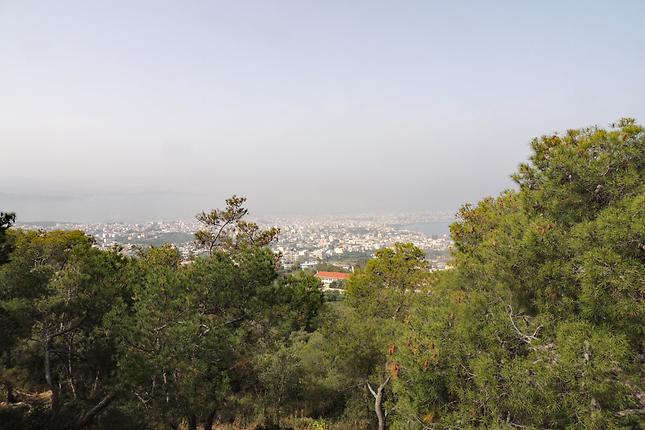
Chania in the distance
Photo: © Werner Gobiet, 14.4.2018
Chania#
Chania
Chaina, Greece
was built on the ruins of the old city of Kydonia. It has a population of 60.000. In the old city motorized traffic is all but forbidden. This part of the city is full of markets, bazars, and boasts a medival harbour, a place for a stroll for both local and tourists in the evenings. Many restaurants and coffee-houses in the harbour area invite you to stay for the rest of the day. Chania and Rethmyon are often said to be the most beautiful cities on Crete.
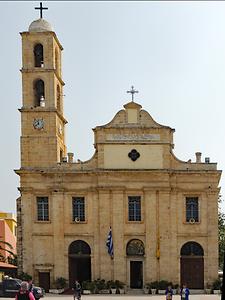
Catholic church
Photo: © Werner Gobiet, 14.4.2018
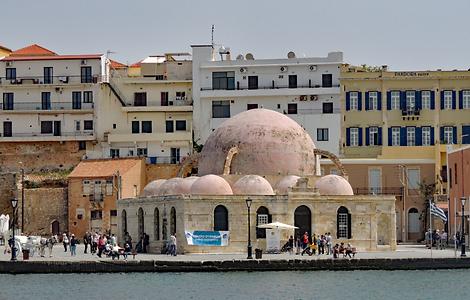
Janissaries-Mosque, oldest turkish building (1645), exhibit area today
Photo: © Werner Gobiet, 14.4.2018

Chania
Photo: © Werner Gobiet, 14.4.2018
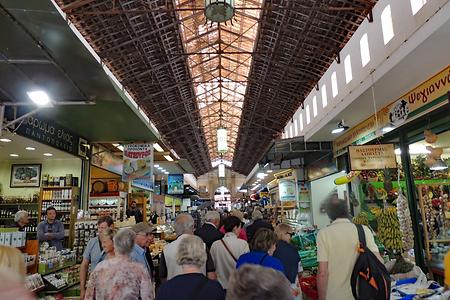
Markethall (built 1911)
Photo: © Werner Gobiet, 14.4.2018
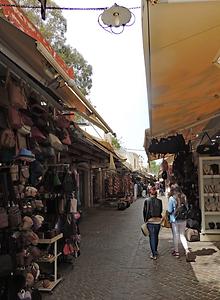
Lane in old city 1
Photo: © Werner Gobiet, 14.4.2018
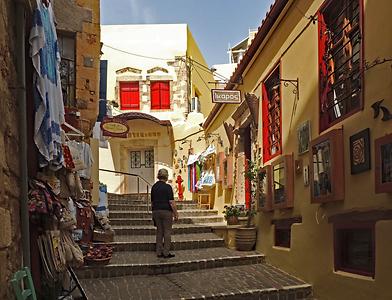
Lane in old city 2
Photo: © Werner Gobiet, 14.4.2018

Lane in old city 3
Photo: © Werner Gobiet, 14.4.2018
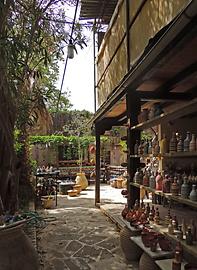
Old city
Photo: © Werner Gobiet, 14.4.2018

Anaggnostas Mantakas (1817 - 1916), Leader for the fight for freedom
Photo: © Werner Gobiet, 14.4.2018

Venitian Harbour
Photo: © Werner Gobiet, 14.4.2018

Coffeehouses and restaurants in the harbour area
Photo: © Werner Gobiet, 14.4.2018
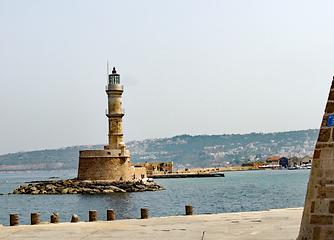
Lighthouse built around 1830
Photo: © Werner Gobiet, 14.4.2018
Antique Aptera#
The old city of Aptera
Aptera, Greece
was built on a hill fittingly named Paleokastro. North of Aptera is the bay of Souda, and in the south the impressive range of Lefka Ori (White mountains). The name Aptera is found in inscriptions of the 13 th and 14 century. A good part of the ongoing excavations is not open to the public.
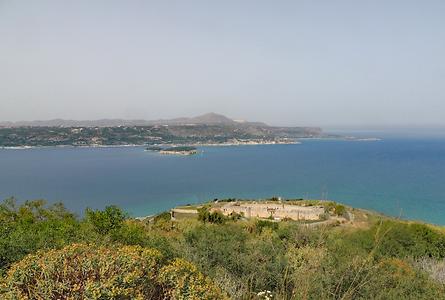
The strategically important Souda bay is in the North
Photo: © Werner Gobiet, 14.4.2018
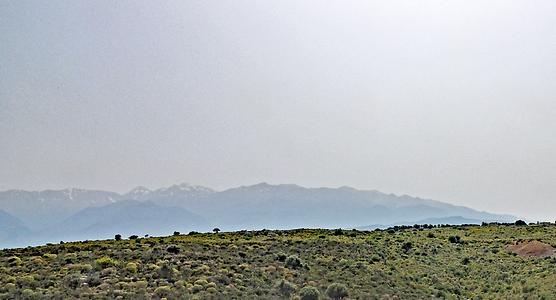
The impressive Lefka Ori (White mountains) in the South
Photo: © Werner Gobiet, 14.4.2018
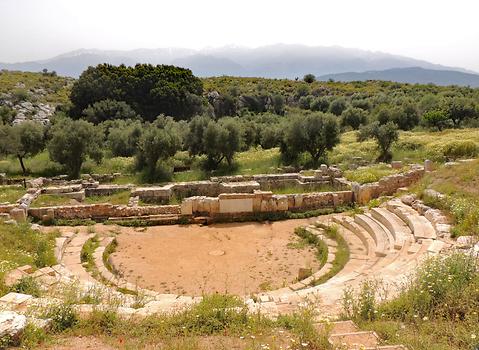
Antique theatre 1
Photo: © Werner Gobiet, 14.4.2018
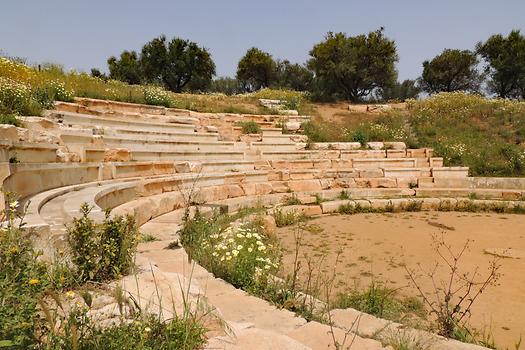
Antique theatre 2
Photo: © Werner Gobiet, 14.4.2018
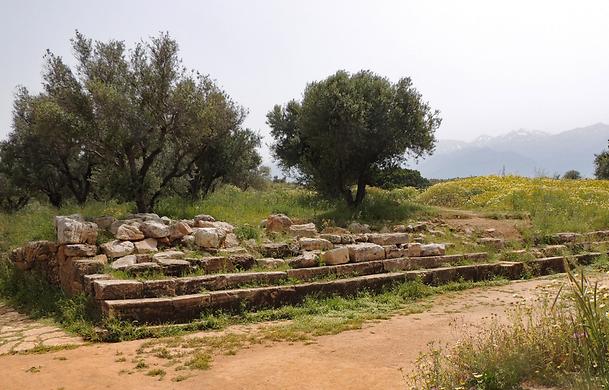
Entrance to theatre
Photo: © Werner Gobiet, 14.4.2018
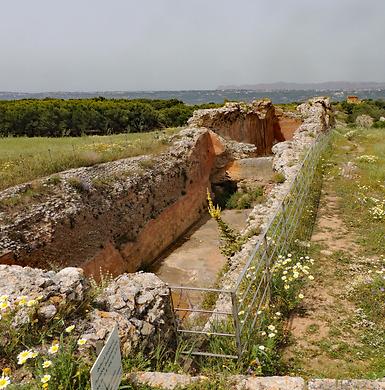
Parts of a Roman villa
Photo: © Werner Gobiet, 14.4.2018
Monastery of Saint Johannes Theologos#
In Aptera a monastery to honour Saint Johannes Theologos was built, but unfortunaly closed in 1964. However, the church is still in use today.
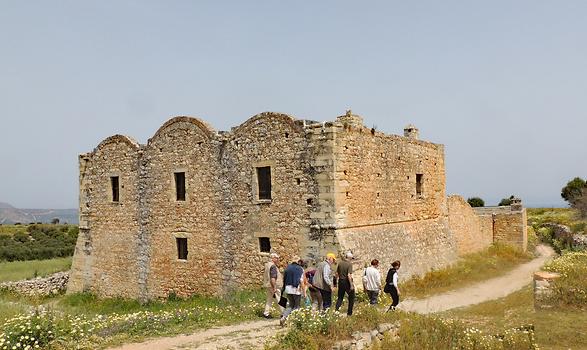
Monastery
Photo: © Werner Gobiet, 14.4.2018
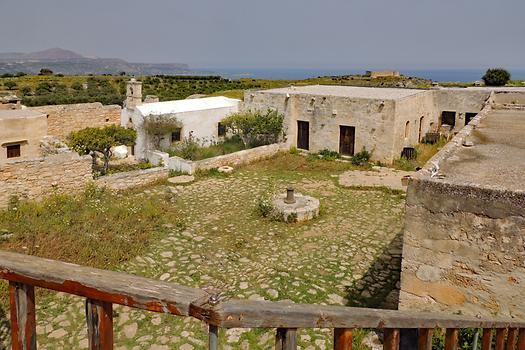
Monastery courtyard
Photo: © Werner Gobiet, 14.4.2018
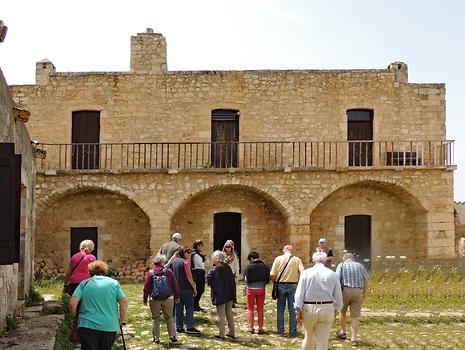
Monastery
Photo: © Werner Gobiet, 14.4.2018
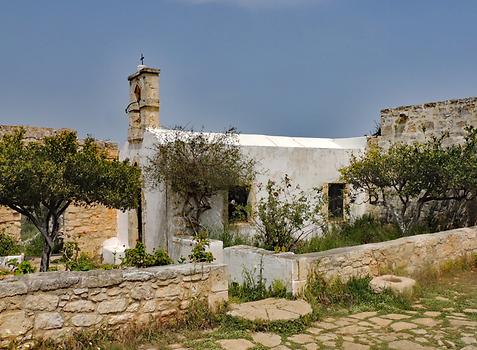
Monastery-church
Photo: © Werner Gobiet, 14.4.2018
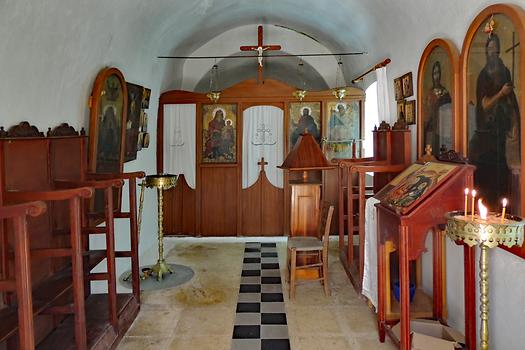
Monastery-church inside
Photo: © Werner Gobiet, 14.4.2018
The fortifications of Koules and Itzedin #
Koules was built by Osmans during the revolution of 1866. Itzedin further down in the village of Kalami
Kalami, Greece
was established in 1872 both for accomodating soldiers and as hospital. After liberation from the Turks it was use as prison and as a place to execute political prisoners.
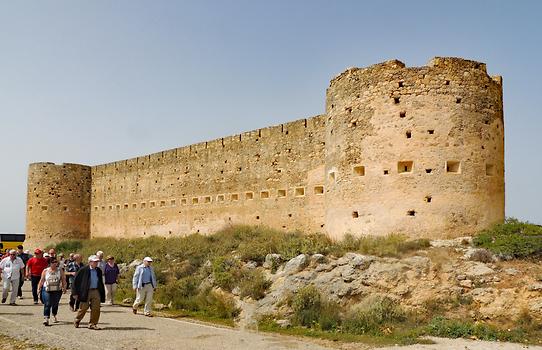
Koules Fortress
Photo: © Werner Gobiet, 14.4.2018
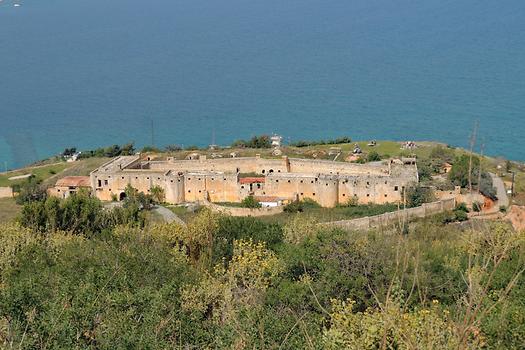
Itzedin Fortres
Photo: © Werner Gobiet, 14.4.2018
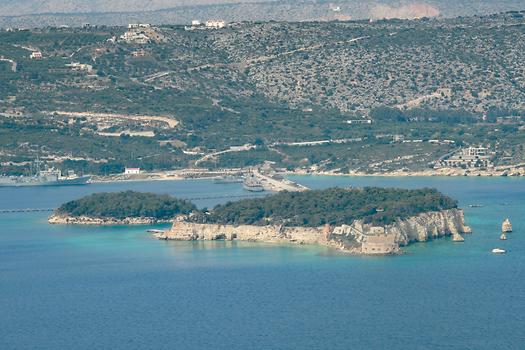
The fortresses allowed to control Souda bay
Photo: © Werner Gobiet, 14.4.2018
Kournas Lake#
This is the most southernmost fresh-water lake
Kournas lake, Greece
of Europe. The water comes form the white mountains mentioned earlier.
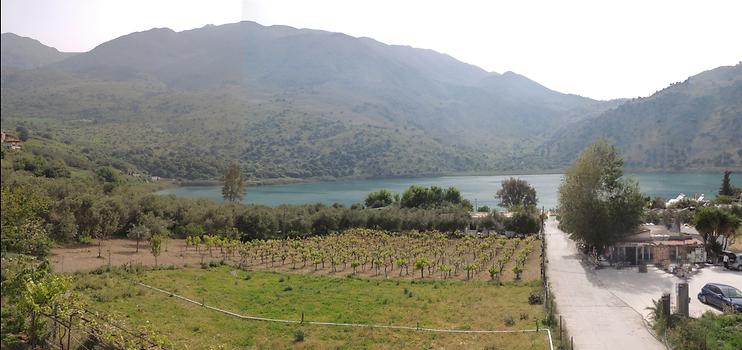
The only fresh water lake on Crete
Photo: © Werner Gobiet, 14.4.2018
Monastery Agios Georgios Selinari#
The Monastery Agios Georgios Selinari is in a beautiful valley. Selinari means "wild gorge" in which the monastery is located. Unfortunately only a small part of the monastery is open to visitors.
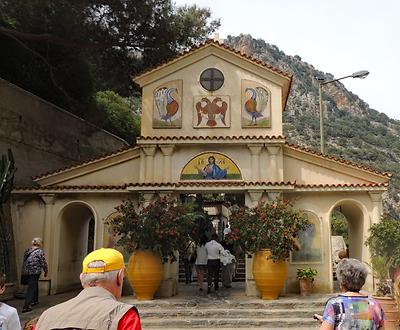
Entrance
Photo: © Werner Gobiet, 15.4.2018
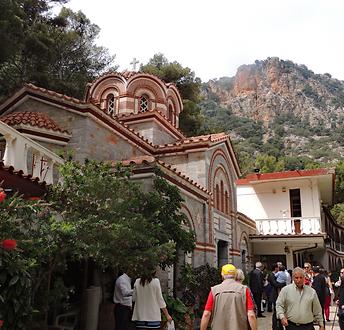
Main building of monastery
Photo: © Werner Gobiet, 15.4.2018
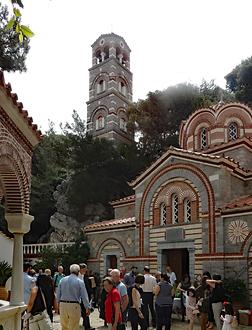
Chapel of monastery
Photo: © Werner Gobiet, 15.4.2018
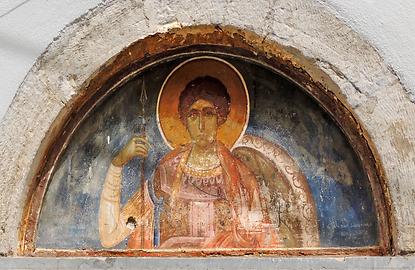
Monastery Selinari
Photo: © Werner Gobiet, 15.4.2018
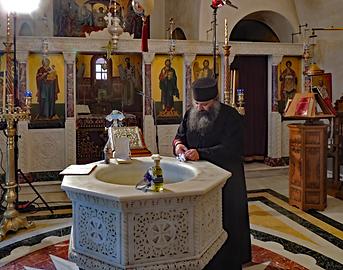
The pope prepares for a baptism
Photo: © Werner Gobiet, 15.4.2018
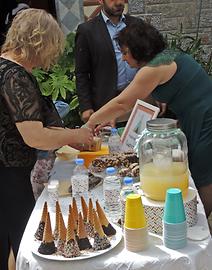
Baptism gifts
Photo: © Werner Gobiet, 15.4.2018
Agios Nikolaos#
Agios Nikolaos
Agios Nikolaos
is one of the bestknown tourist places with very good beaches. The city has a population of some 10.000 and is also in the competition for the title "most beautiful city of Crete". The city is located at the place of the antique village Lato pros Kamara. Voulismeni-Lake is in the center of the city, connected to the open sea with a short channel.
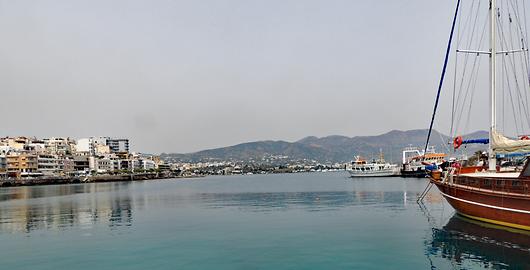
Harbour bay
Photo: © Werner Gobiet, 15.4.2018

Yachtharbour
Photo: © Werner Gobiet, 15.4.2018

Handycrafts
Photo: © Werner Gobiet, 15.4.2018

Agios Nikolaos
Photo: © Werner Gobiet, 15.4.2018
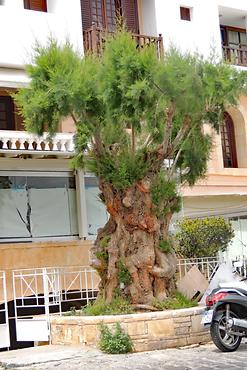
Agios Nikolaos
Photo: © Werner Gobiet, 15.4.2018
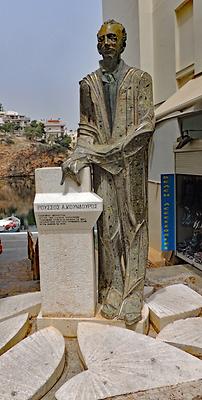
Agios Nikolaos
Photo: © Werner Gobiet, 15.4.2018
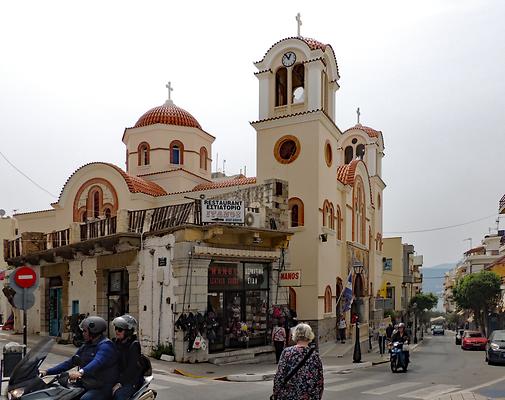
Orthodox church Agia Trada
Photo: © Werner Gobiet, 15.4.2018
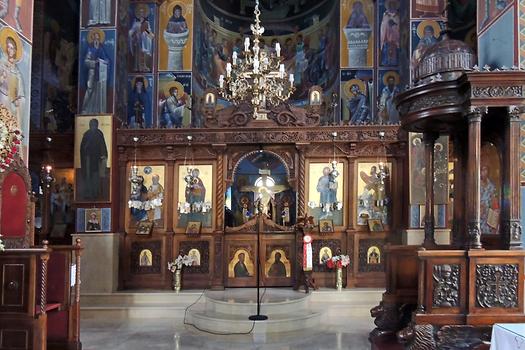
Room in front of altar
Photo: © Werner Gobiet, 15.4.2018
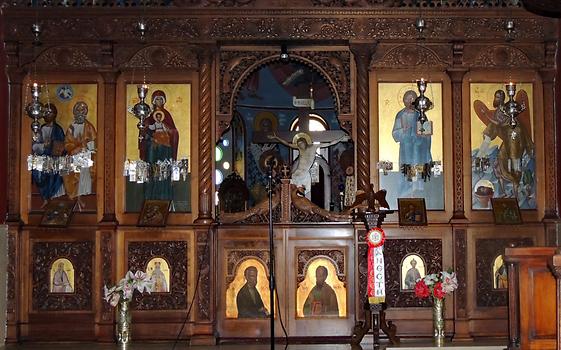
Iconostasis
Photo: © Werner Gobiet, 15.4.2018

Cupula of church
Photo: © Werner Gobiet, 15.4.2018

Gallery
Photo: © Werner Gobiet, 15.4.2018
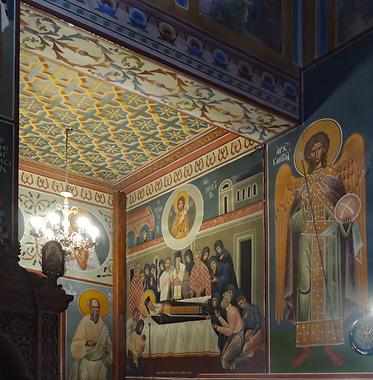
Agios Nikolaos
Photo: © Werner Gobiet, 15.4.2018
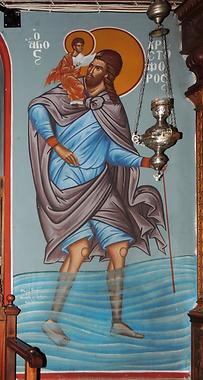
Saint Christophorus
Photo: © Werner Gobiet, 15.4.2018
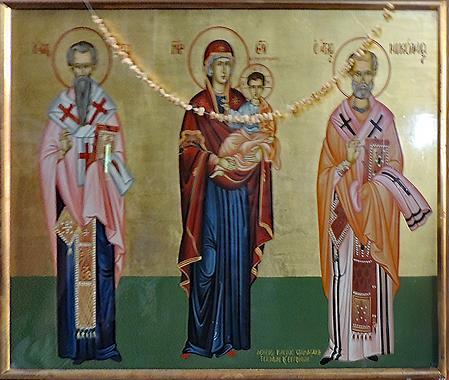
Mary with child Jesus
Photo: © Werner Gobiet, 15.4.2018
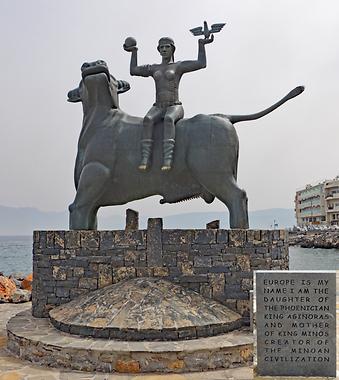
Europa on the Bull
Photo: © Werner Gobiet, 15.4.2018
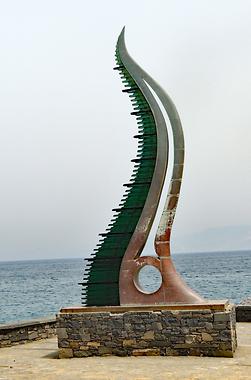
Agios Nikolaos
Photo: © Werner Gobiet, 15.4.2018
Island Spinalonga#
The Island Spinalonga
Spinalonga, Crete
has a complex history. It is important since it controls the entrance to the gulf of Elounda. Hence the island was fortified to protect the harbour Olous already in ancient times. The Venetians built a strong fortification on its ruins in the 16 tht century. However, Osmans conquered the fortress in 1715. Some 600 Christians living on the island were deported, and Muslims started to live there. In 1881 their number was around 1.100. After the independence of Crete the islanda was used as a Leper colony (from 1903 to 1957), forcing all other inhabitants to leave. The island can be visited as part of a guided tour.
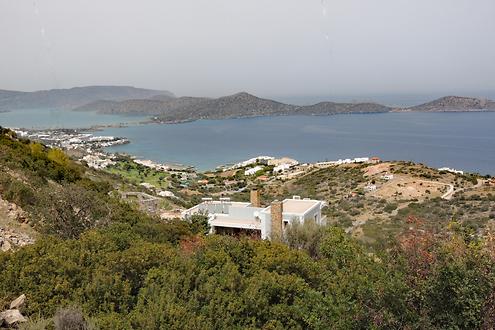
Approach via the mountains
Photo: © Werner Gobiet, 15.4.2018

By boat to the island
Photo: © Werner Gobiet, 15.4.2018

Spinalonga- South side
Photo: © Werner Gobiet, 15.4.2018

Spinalonga- Westside
Photo: © Werner Gobiet, 15.4.2018
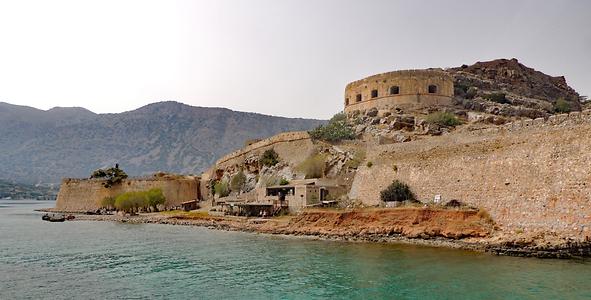
Spinalonga- SE Side
Photo: © Werner Gobiet, 15.4.2018
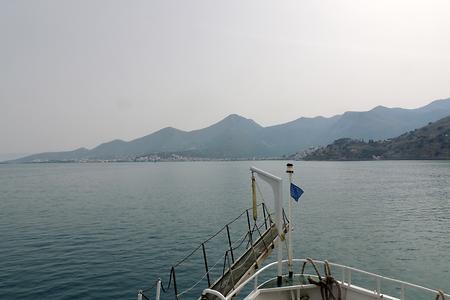
Returning to Agios Nikolaos
Photo: © Werner Gobiet, 15.4.2018
Palace of Knossos#
Knossos
Knossos, Crete
is the largest Bronze Age archaeological site on Crete and has been called Europe's oldest city. The ancient city was once the center of the Minoan culture and is particulalry known because of the palace of Knossos. In this arae of a neolithic settlement a large, impressive and rich palace was built between 2.100 and 1.800 BC. It was destroyed by a massive earthquake around 1.700 BC, with addititonal damage done by a second quake around 1.400 BC.
Sir Arthur Evans, who unearthed the palace of Knossos in modern times, estimated that about 7.000 BC a Neolithic people arrived at the hill, probably from overseas by boat, and started the first of a succession of villages.
Crete had a number of similar palaces (see below). However, at the height of Cretan power around 1,450 BC the palaces at Mallia, Phaestus and Zakro were destroyed along with smaller settlements elsewhere. Only Knossos remained and it survived till about 1370. At the time of its destruction, it was occupied by Greeks whose presence is suggested by a new emphasis on weapons and warfare in both art and burial. The Mycenaean-style chamber tombs had been adopted and there was a mainland influence on pottery style. Confirmation came from writing after Michael Ventris deciphered the Linear B tablets and showed them to be written in an early form of Greek which was quite unlike the earlier Linear A. Sir Arthur Evans found the Linear B tablets at Knossos and, although the writing was different from the Linear A ones at Phaestus and elsewhere, he thought they were a development based on the first and so called them Linear B.
Despite speculation that Knossos was destroyed by the volcanic eruption on Santorini, it is generally accepted that the cause was human violence following an invasion of Crete by Greeks from the Argolid, most probably Mycenaean. Knossos was still prosperous at the time of its destruction in 1.370 with trade and art continuing to thrive. Reasons for its destruction are speculative but a likely one is that the Mycenaeans, now prospering on the mainland, decided to remove a rival power.
It is sometimes believed that Knossos palace contained the famous labyrinth of Minotaur, a monster that was finally killed by Theseus who used Ariandne's advice to escape from the maze using a thread attached to the entrance that he would use to find the way out. However, this early suggestion by Sir Arthur Evans has never been verified.
More on Knossos see https://en.wikipedia.org/wiki/Knossos.
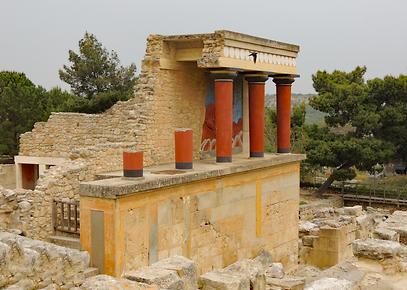
Reconstructed N entrance
Photo: © Werner Gobiet, 16.4.2018
' width='407'}]

Entrance street
Photo: © Werner Gobiet, 16.4.2018
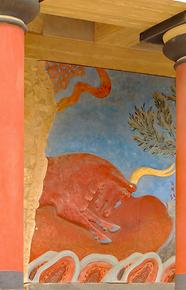
Panel in entrance
Photo: © Werner Gobiet, 16.4.2018

Excavated Courtyard
Photo: © Werner Gobiet, 16.4.2018

Chamber for provisions
Photo: © Werner Gobiet, 16.4.2018
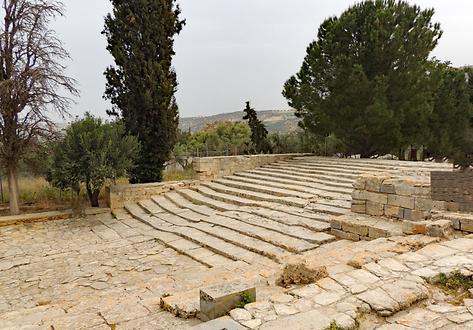
Road for prcessions
Photo: © Werner Gobiet, 16.4.2018
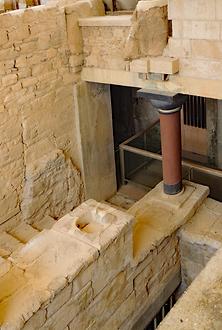
Reconstructed part of staircase
Photo: © Werner Gobiet, 16.4.2018

Excavated stairs
Photo: © Werner Gobiet, 16.4.2018
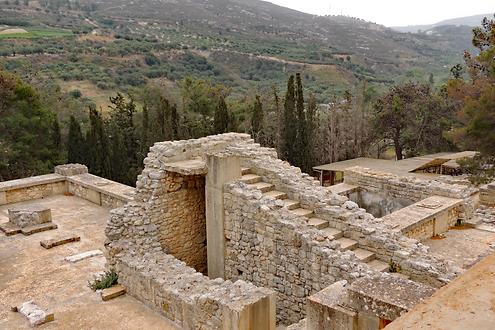
Reconstructed part of the building
Photo: © Werner Gobiet, 16.4.2018
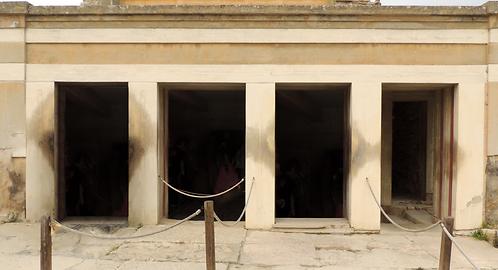
Entrance to hall of the throne
Photo: © Werner Gobiet, 16.4.2018
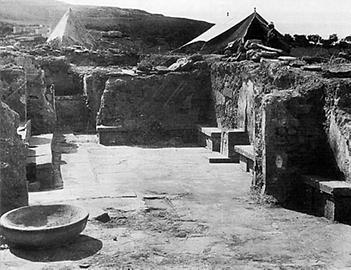
Original view of the hall of the throne.
Photo: Wardle. From:
Wikicommons,
under PD
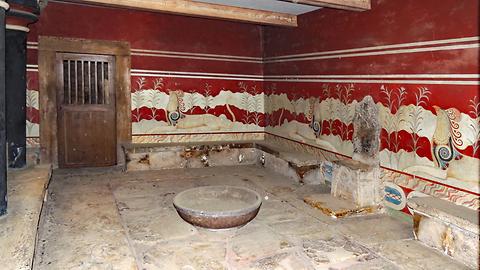
Comparison with reconstructed hall of the throne
Photo: © Werner Gobiet, 16.4.2018
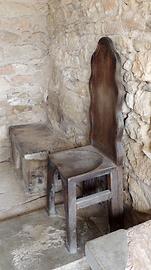
Wooden copy of the throne of Alabaster
Photo: © Werner Gobiet, 16.4.2018
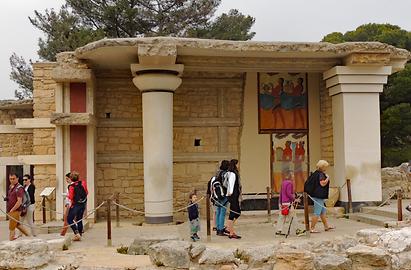
Reconstructed part of building
Photo: © Werner Gobiet, 16.4.2018
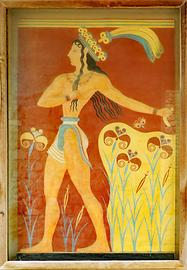
Reconstructed panel
Photo: © Werner Gobiet, 16.4.2018
Archeologiacl museum of Iraklion#
The Archeologiacl museum of Iraklion houses some particularly spectacular archeological finds including items found in Knossos and Phaistos, like a small sculpture of the snake godesss.
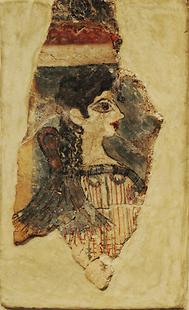
The "Parisian" found in Knossos
Photo: © Werner Gobiet, 16.4.2018

Small snake-godess from the treasure chamber of Knossos
Photo: Olaf Tausch. From:
Wikicommons,
under CC BY 3.0

Reconstructed panel
Photo: © Werner Gobiet, 16.4.2018

Reconstructed panel
Photo: © Werner Gobiet, 16.4.2018
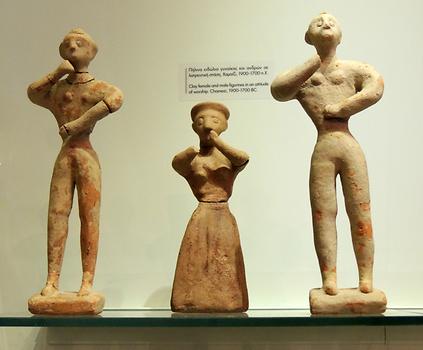
Small figurines 1
Photo: © Werner Gobiet, 16.4.2018
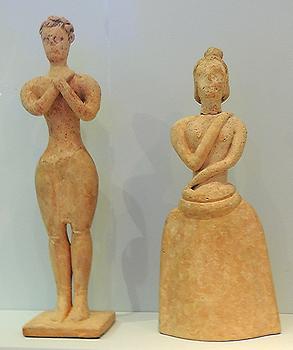
Small figurines 2
Photo: © Werner Gobiet, 16.4.2018
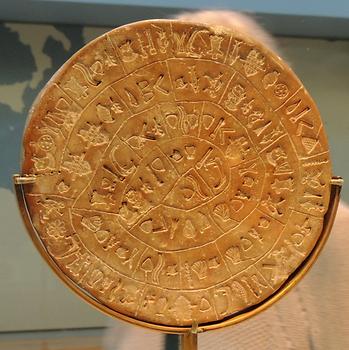
The famous disc of Phaistos
Photo: © Werner Gobiet, 16.4.2018
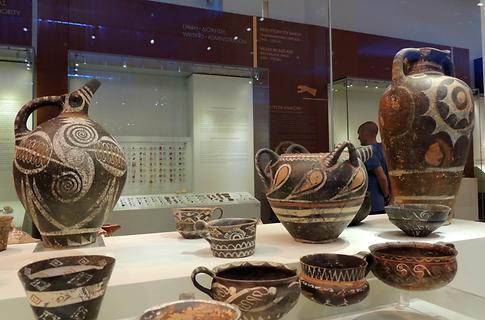
Ceramic objects of utility
Photo: © Werner Gobiet, 16.4.2018

Golden jewellery
Photo: © Werner Gobiet, 16.4.2018

Golden jewellery from Malia: two bees with a drop of honey
Photo: © Werner Gobiet, 16.4.2018

Leda and Scwan
Photo: © Werner Gobiet, 16.4.2018
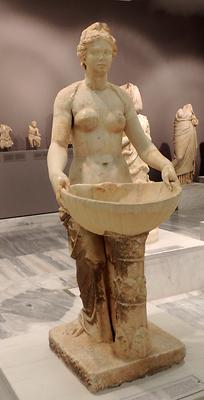
Figure with bowl
Photo: © Werner Gobiet, 16.4.2018
Iraklion city#
Iraklion (Heraklion)
Iraclion, Greece
is the capital of Crete. By the official count of 2011 it has a population of 173.000. In Minoian times one of the four harbours of Knossos was quite close to the city. According to myth, Herakles landed here to capture the bull of Crete.
From 824 to 1206 rulers were first Muslims and later Byzantines. Then Venetians took over till 1699. But then Osmans ruled till 1913. After a bloody massacre of Greeks and Christians a kind of autonomy was obtained in 1898. As mentioned before, Crete was united with Greece in 1913. The city was heavily bombarded and damaged in 1941.
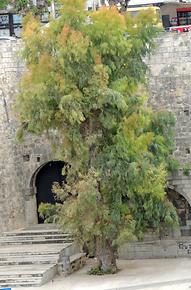
The city wall is intact E of the center
Photo: © Werner Gobiet, 16.4.2018
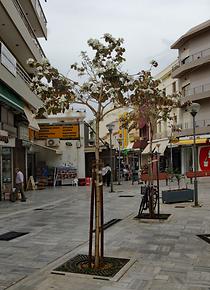
Pedestrian-zone 1
Photo: © Werner Gobiet, 16.4.2018
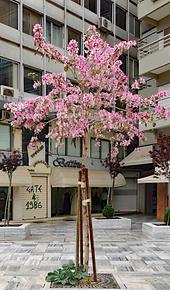
Pedestrian-zone 2
Photo: © Werner Gobiet, 16.4.2018

Morozini-Fountain (Venitian Lion Fountain)
Photo: © Werner Gobiet, 16.4.2018

Water for the city
Photo: © Werner Gobiet, 16.4.2018
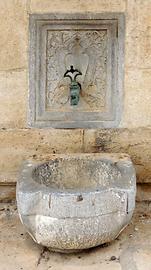
Public fountain
Photo: © Werner Gobiet, 16.4.2018

Old place to get water
Photo: © Werner Gobiet, 16.4.2018
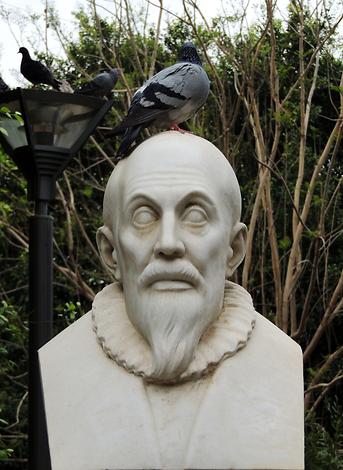
El Greco (Dominikos Theotokópoulos 1541 - 1614) comes from Crete
Photo: © Werner Gobiet, 17.4.2018
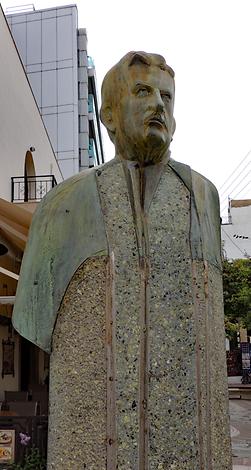
Politician
Photo: © Werner Gobiet, 17.4.2018
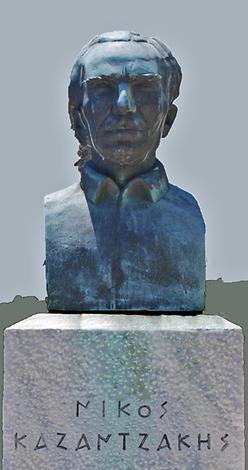
Nikos Kazantzakis, Autor of "Alexis Sorbas" is buried in Iraklion
Photo: © Werner Gobiet, 17.4.2018

Harbour Fortification Koules
Photo: © Werner Gobiet, 17.4.2018
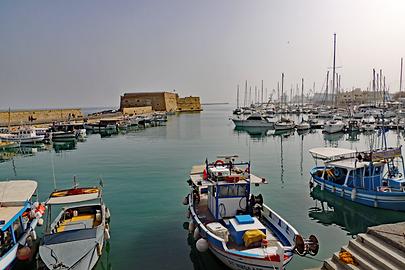
Venetian Harbour
Photo: © Werner Gobiet, 17.4.2018
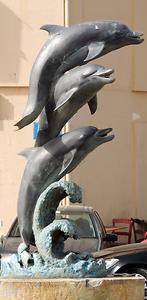
Sculpture of dolphins
Photo: © Werner Gobiet, 17.4.2018

Fresh catch in the harbour
Photo: © Werner Gobiet, 17.4.2018
Palace of Phaistos#
Phaistos
Phaistos, Crete
is on a hill overlooking the Messara plane. Italian archeologists have been excavating the palace since around 1900. They are not using colours or concrete to preserve the original as much as possible. The palace was built between 2.000 an 1.700 BC, was destroyed by fire in the 17 th century BC, rebuilt, but evenutally destroyed and abandoned in the 15 century BC.
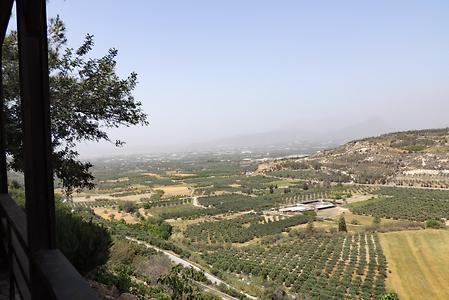
Plane of Messara
Photo: © Werner Gobiet, 17.4.2018
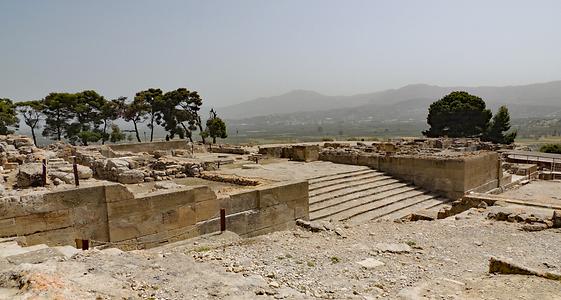
Palace of Phaistos
Photo: © Werner Gobiet, 17.4.2018
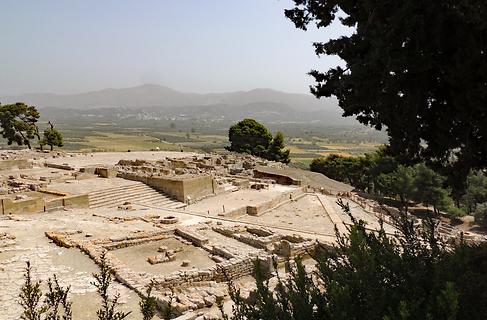
Palace of Phaistos
Photo: © Werner Gobiet, 17.4.2018
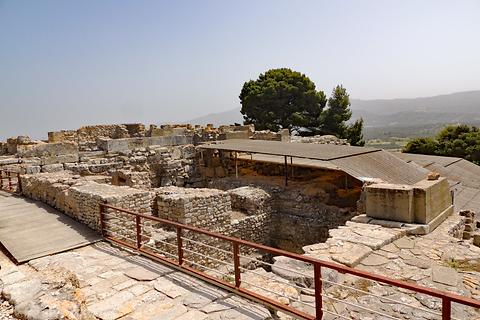
Palace of Phaistos
Photo: © Werner Gobiet, 17.4.2018
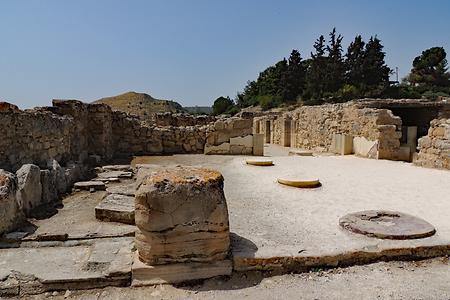
Palace of Phaistos
Photo: © Werner Gobiet, 17.4.2018
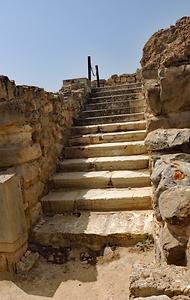
Palace of Phaistos
Photo: © Werner Gobiet, 17.4.2018
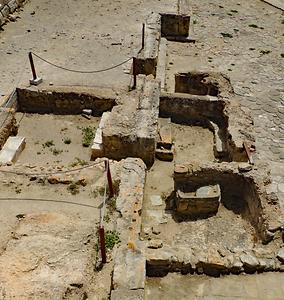
Palace of Phaistos
Photo: © Werner Gobiet, 17.4.2018

Palace of Phaistos
Photo: © Werner Gobiet, 17.4.2018

Palace of Phaistos
Photo: © Werner Gobiet, 17.4.2018
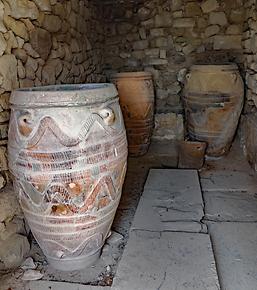
Palace of Phaistos
Photo: © Werner Gobiet, 17.4.2018
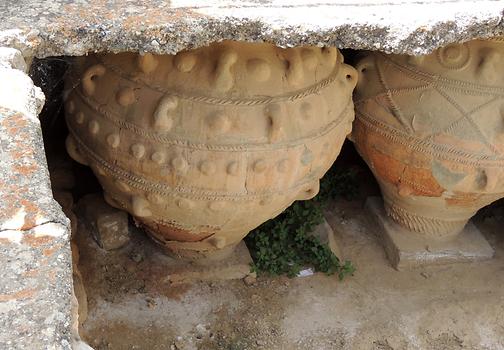
Palace of Phaistos
Photo: © Werner Gobiet, 17.4.2018
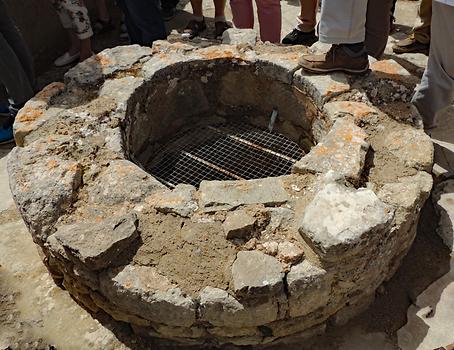
Palace of Phaistos
Photo: © Werner Gobiet, 17.4.2018
Matala#
The best known sea resort in the Messara plane is Matala
Matala, Crete
. Very close to the beach there are historic burial caves, others were used to live in. The origin of the caves is unknown, but it is usually assumed that all caves were used as burial chambers by the Romans. In the 1960-ties Hippies - flower children- were attracted by the caves. During this time a stump of a tree was converted into an elaborate sculpture. The caves are under monument protection today.
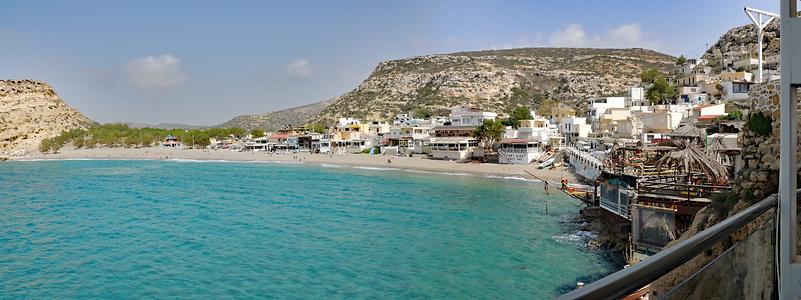
Beach of Matala
Photo: © Werner Gobiet, 17.4.2018
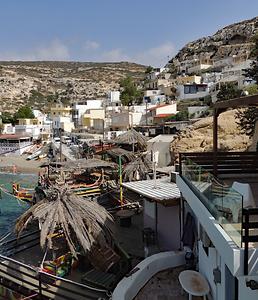
Matala
Photo: © Werner Gobiet, 17.4.2018
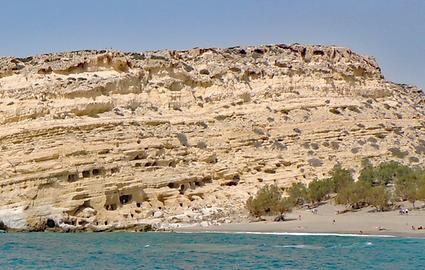
Old caves
Photo: © Werner Gobiet, 17.4.2018
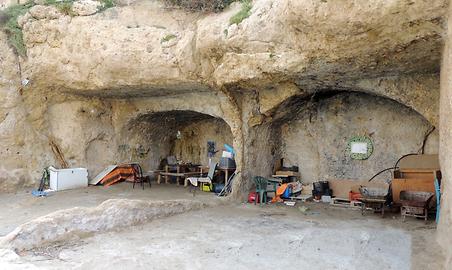
Those caves are still in use
Photo: © Werner Gobiet, 17.4.2018
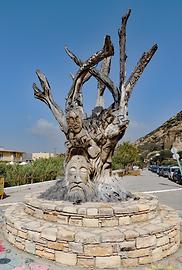
Tree stump as reminder of the hippies
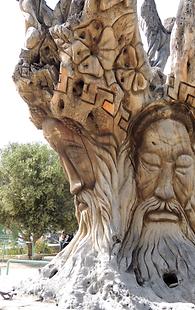
Tree stump as sculptured by hippies
Photo: © Werner Gobiet, 17.4.2018
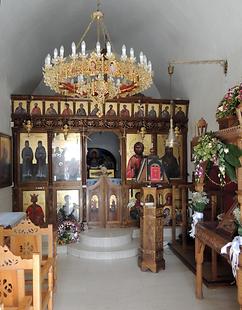
Orthodox church
Photo: © Werner Gobiet, 17.4.2018
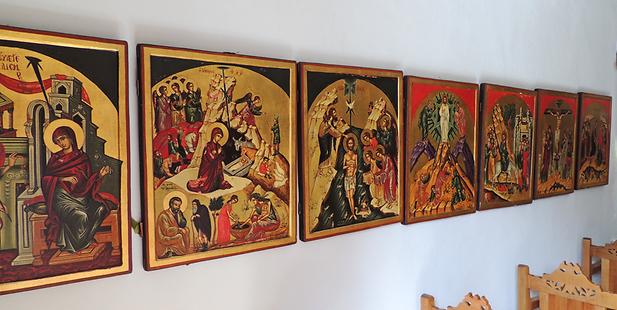
Pictures in the orthodox church
Photo: © Werner Gobiet, 17.4.2018

The fertile Messara valley 1
Photo: © Werner Gobiet, 17.4.2018

The fertile Messara valley 2
Photo: © Werner Gobiet, 17.4.2018
Palace of Malia#
The palace of Malia
Malia
was built in Minoian times around 1.900 BC. Like Knossos it was destroyed by two earthquakes, one around 1.750 BC, the second 1.450 BC. When the remainder of ancient walls was dicovered by the Greek archeologist Iosif Chatzidakis in 1915 excavation started, and has continued since.
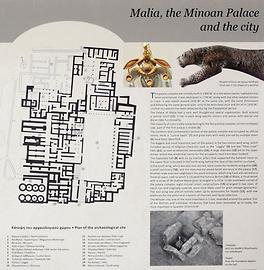
Map
Photo: © Werner Gobiet, 17.4.2018
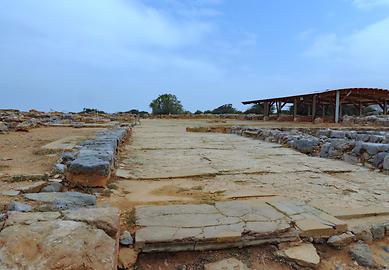
Entrance area
Photo: © Werner Gobiet, 17.4.2018
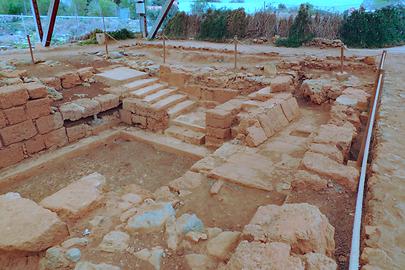
Southern part
Photo: © Werner Gobiet, 17.4.2018
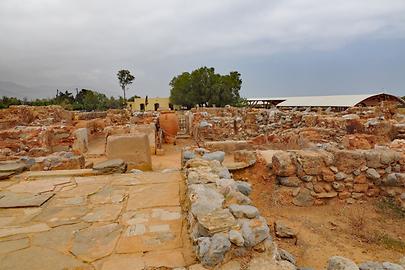
Hypostyle hall
Photo: © Werner Gobiet, 17.4.2018

Storage silos 1
Photo: © Werner Gobiet, 17.4.2018
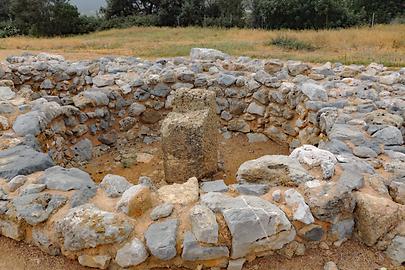
Storage silos 2
Photo: © Werner Gobiet, 17.4.2018
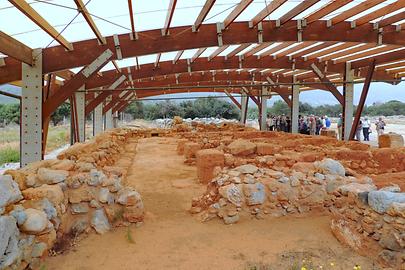
Eastside storage
Photo: © Werner Gobiet, 17.4.2018
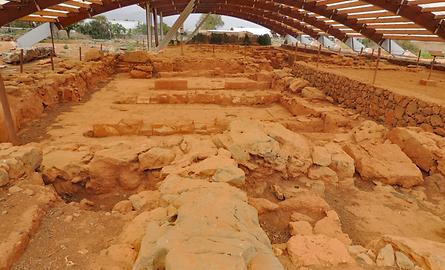
Westside storage
Photo: © Werner Gobiet, 17.4.2018
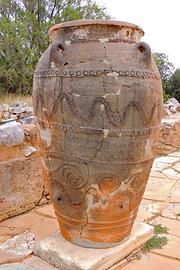
Storage vessel
Photo: © Werner Gobiet, 17.4.2018
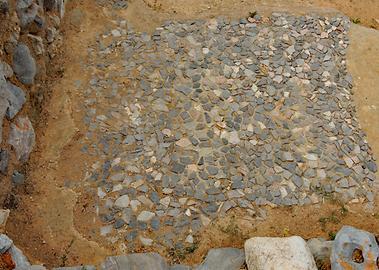
Groundfloor with mosaics
Photo: © Werner Gobiet, 17.4.2018

Floorcover
Photo: © Werner Gobiet, 17.4.2018
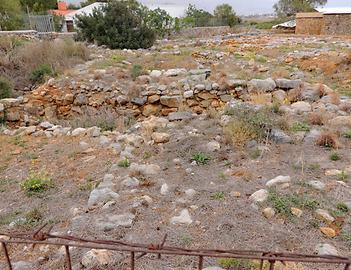
This area has not been excavated yet
Photo: © Werner Gobiet, 17.4.2018

...and much more is still to be done!
Photo: © Werner Gobiet, 17.4.2018
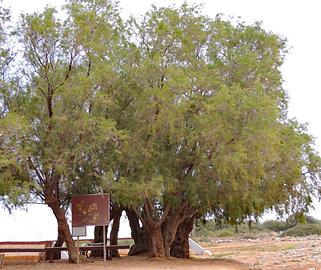
Malia
Photo: © Werner Gobiet, 17.4.2018
The Lassithi plateau#
The Lassithi plateau
Lasithi plateau, Crete
at an altitude of about 830 m is some 10 km long and 5-7 km wide. It is surrounded by mountains and and only be reached via two roads, crossing some mountain-passes. The roughly 20 villages house somes 5.000 people. The plane is is fertile and is used intensly for agriculture.
The old wind wheels that were used to pump water up from the valley to the Lassithi plane are the famous landmarks of the plane. Most pumps are operated by dieselmotors these days. Some 8.000 suche pumps are still in operation.
The Lassithi plateau is also known for the sacred Psychro Cave
Pschro cave, Crete
, associated with the Diktaean Cave, one of the putative sites of the birth of Zeus. Other legends put the place of birth of Zeuss in the Idaean Cave on Mount Ida, west and inland of Iraklion.

Driving up to the Lassithi plateau
Foto: © Werner Gobiet, 17.4.2018

Villages en route
Foto: © Werner Gobiet, 17.4.2018
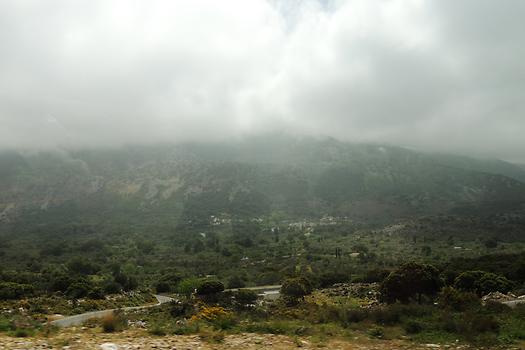
Small villages are at the foot of the mountains.
Foto: © Werner Gobiet, 17.4.2018
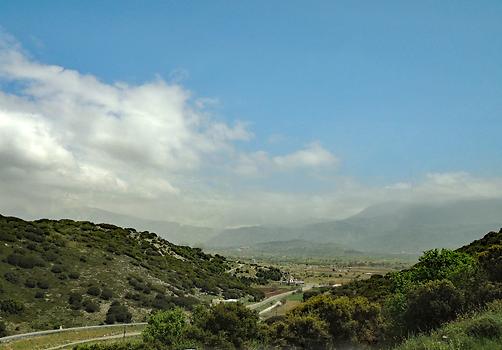
Lassithi-Plateau
Foto: © Werner Gobiet, 17.4.2018
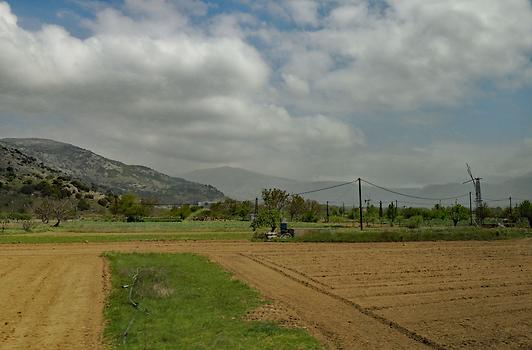
The Lassithi-Plateau is very fertile
Foto: © Werner Gobiet, 17.4.2018
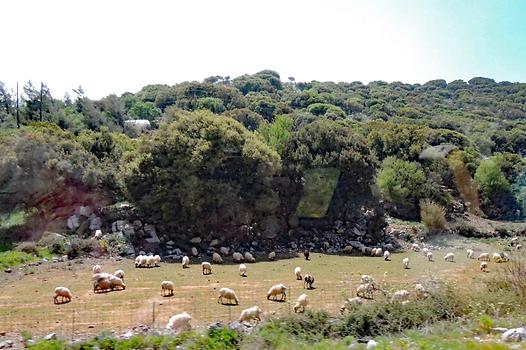
Sheep
Foto: © Werner Gobiet, 17.4.2018
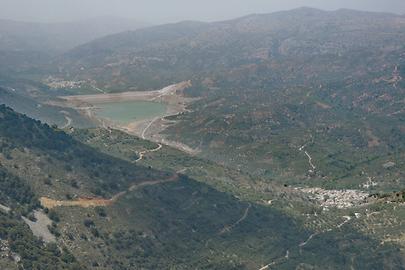
Water reservoirs are to provide enough water. However, in 2018 there was not enough rain to fill them.
Foto: © Werner Gobiet, 17.4.2018
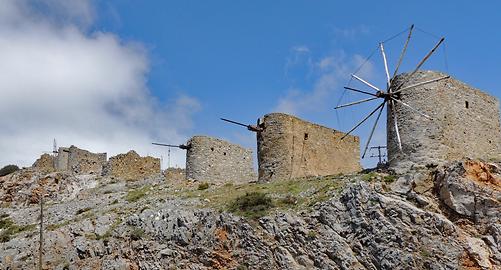
Windmills to pump water
Foto: © Werner Gobiet, 17.4.2018
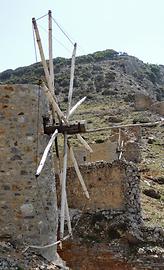
Sailing cloth is used for the rotor blades
Foto: © Werner Gobiet, 17.4.2018
Here is a sample of one of the few intact widnmills: #
Reactivated Windmill#
On the edges of the Lassithi-plain wind has been used for grinding grain for 3.000 years.
Am Rande der Lassithi-Hochebene wurde bereits vor 3000 Jahren der Wind für das Mahlen von Körnen genutzt.
Monastery Kera#
The monastery of the mistress (Kera) Kardiotissa is dedicated to the god mother. It is an old nunnery that was already mentioned in 1333, since the monastery obtained in that year an icon capable of performing miracles. Three nuns are keeping the monastery in shape today: it is still a favorite place for pilgrimages.

Monastery courtyard 1
Photo: © Werner Gobiet, 17.4.2018
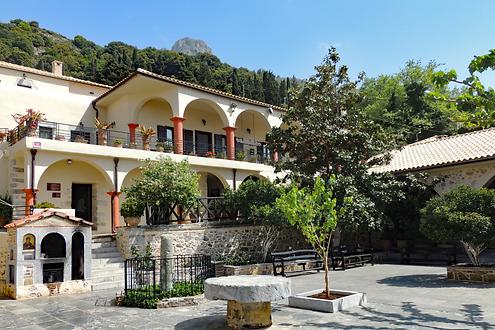
Monastery courtyard 2
Photo: © Werner Gobiet, 17.4.2018
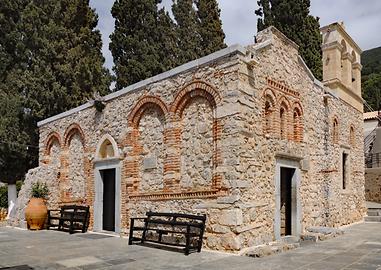
Monastery church
Photo: © Werner Gobiet, 17.4.2018
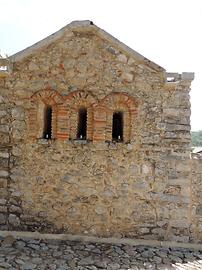
Backside of church
Photo: © Werner Gobiet, 17.4.2018

Walking around the church
Photo: © Werner Gobiet, 17.4.2018
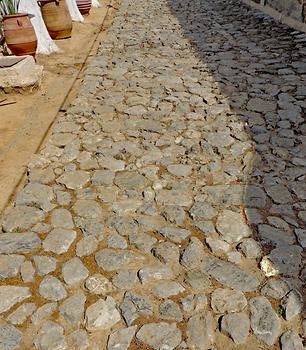
Floorcover
Photo: © Werner Gobiet, 17.4.2018

The mircale icon was firmly attached to this column by the Turks, but it returned three times.
Photo: © Werner Gobiet, 17.4.2018

Cultic object
Photo: © Werner Gobiet, 17.4.2018

Panel
Photo: © Werner Gobiet, 17.4.2018

Door of an iconostasis
Photo: © Werner Gobiet, 17.4.2018
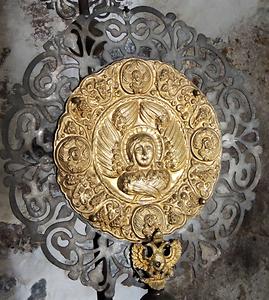
Head of the abbot

A gospel book from 1865
Photo: © Werner Gobiet, 17.4.2018
Mountain village Krasi#
The mountain village Krasi
Krsi, Crete
is famous for its gigantic 14,6 m high platane tree.
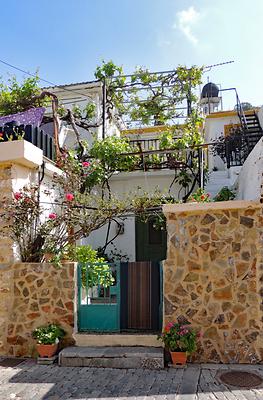
House
Photo: © Werner Gobiet, 17.4.2018
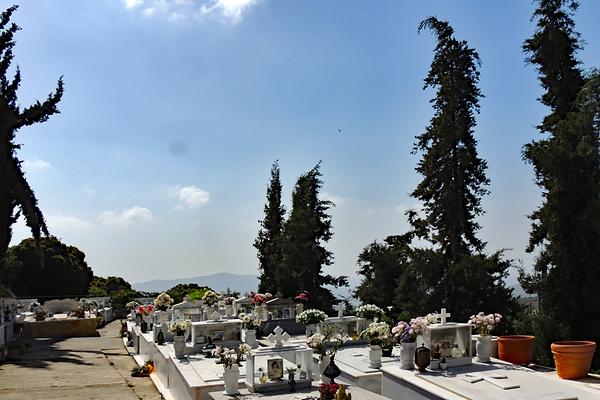
Churchyard
Photo: © Werner Gobiet, 17.4.2018
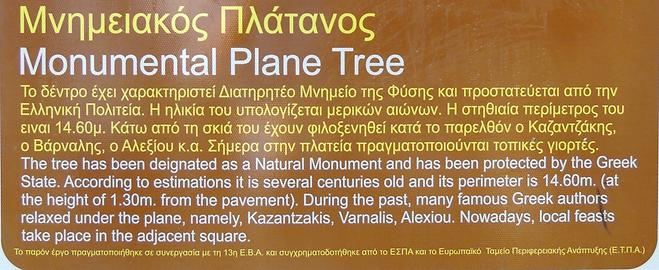
Description of giant platane tree
Photo: © Werner Gobiet, 17.4.2018
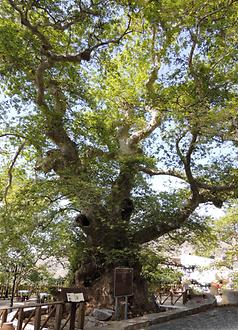
Giant platane tree
Photo: © Werner Gobiet, 17.4.2018
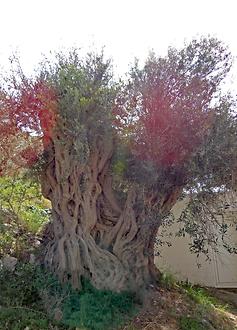
Olive tree
Photo: © Werner Gobiet, 17.4.2018
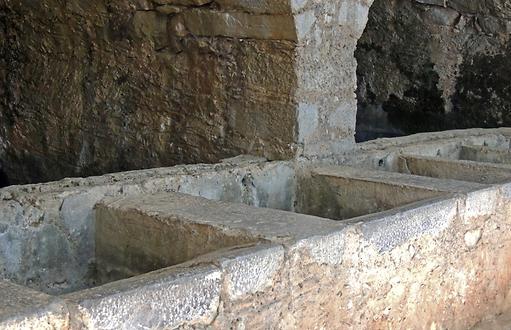
Collecting tank for water
Photo: © Werner Gobiet, 17.4.2018
Sources#

